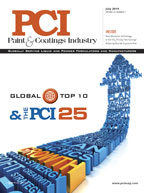Covestro Confirms Full-Year Guidance Despite Weak Economic Activity

Courtesy of Covestro.
In a continuing weak economic environment, Covestro achieved its EBITDA guidance for the second quarter of 2023 of EUR 330 million to EUR 430 million. Group sales decreased year-on-year by 20.9 percent to EUR 3.7 billion (previous year: EUR 4.7 billion). This is mainly due to a demand-related decline in the selling price level and a drop in volumes sold. Combined with lower margins, that resulted in a 29.6 percent fall in EBITDA to EUR 385 million (previous year: EUR 547 million). Net income was EUR 46 million, a year-on-year fall of 76.9 percent (previous year: EUR 199 million). The free operating cash flow (FOCF) increased from EUR –462 million in the prior-year quarter to EUR –10 million.
"The second quarter of the year was characterized by continued economic weakness and weak demand worldwide. Nevertheless, we achieved our targets for the quarter and are confirming our full-year guidance," says Dr. Markus Steilemann, CEO of Covestro. "Our focus in this difficult environment is on operating in an efficient and cost-conscious manner. We will continue to serve our customers’ needs in the best possible way, while creating the right foundation for sustainable growth and our vision of becoming fully circular."
Full-Year Guidance for 2023 Confirmed
Covestro is confirming its guidance for fiscal 2023. As announced this April, the Group expects EBITDA to be between EUR 1.1 billion and EUR 1.6 billion. The Group anticipates free operating cash flow of between EUR 0 million and EUR 500 million and ROCE above WACC of between –6.0 percentage points and –2.0 percentage points. Covestro’s GHG emissions measured as CO2 equivalents are projected to be between 4.2 million metric tons and 4.8 million metric tons. Against the backdrop of an anticipated economic downturn in the further course of the year, Covestro currently expects results to be rather in the lower half of the specified ranges for all key performance indicators. Covestro anticipates EBITDA for the third quarter of 2023 to be between EUR 240 million and EUR 340 million.
"The second quarter was in line with our expectations, but we still face a challenging economic environment," says Dr. Thomas Toepfer, Covestro’s CFO and Labor Director. "We currently still do not anticipate an economic recovery in the remainder of the year."
Dr. Klaus Schäfer, Covestro’s Chief Technology Officer, left the Group and retired at the end of the second quarter of 2023. On July 1, 2023, his successor, Dr. Thorsten Dreier, took charge of the corporate functions of Process Technology, Engineering, Group Health, Safety and Environment, and Group Procurement.
First Major Contract for Renewable Energies for The U.S. Business
In order to drive its vision of becoming fully circular, Covestro is committed to using renewable energies, among other things. To enable that, the Group is concluding power purchase agreements (PPAs) and is successively converting its sites worldwide to electricity from renewable sources. This June, Covestro concluded a virtual power purchase agreement for its U.S. business for the first time in order to cut CO2 emissions at its third-largest production site in Baytown, Texas, United States. That is expected to offset an estimated 70,000 tons of CO2 emissions a year, from the end of 2024. The contractual partner is once again the Danish energy utility Ørsted, which will also meet 10 percent of the energy requirements at Covestro’s German sites from renewable sources from 2025 onward. As of the end of 2022, Covestro already obtains 12 percent of its global demand through electricity from renewable sources and is aiming to increase that figure to up to 18 percent in 2023.
Another key driver for the circular economy is the digital transformation. In this context, Covestro is also increasingly relying on data-focused corporate management, with a particular focus on the areas of production, research and development, and supply chain management. The Group recently developed an app for calculating the carbon footprint of its products. Covestro’s climate impact in manufacturing its products can be assessed using the product carbon footprint from cradle to gate. It can currently be calculated for about 50,000 intermediate and finished products. Covestro is now validating the results in order to make them gradually available to customers from 2024 onward and thus potentially help reduce emissions on the customer’s side. In addition to the carbon footprint, the app also enables the calculation of other environmental impact categories.
Challenging Environment and Weak Demand Impact Segments
Sales in the Performance Materials segment fell by 27.3 percent to EUR 1.8 billion (previous year: EUR 2.5 billion). That was due, in particular, to lower average selling prices and a decline in volumes sold, primarily as a result of weak demand worldwide, combined with availability constraints, especially in the EMLA region. The segment’s EBITDA declined by 17.7 percent year-on-year to EUR 302 million (previous year: EUR 367 million), in particular due to lower margins as a result of weak demand. The free operating cash flow fell by 108.1 percent to EUR –77 million (previous year: EUR –37 million).
The Solutions & Specialties segment posted a 13.5 percent fall in sales to EUR 1.9 billion in the second quarter (previous year: EUR 2.2 billion) due to a lower selling price level and a decline in volumes sold. This is attributable to the weak demand situation, compared to the advantageous competitive situation in the prior-year quarter. EBITDA rose year-on-year by 3.8 percent to EUR 221 million (previous year: EUR 213 million), mainly due to lower fixed costs and the sale of the Additive Manufacturing Business this April. Despite the weak economic environment, the segment was able to increase its margins by two percentage points compared to the prior-year quarter. The segment’s free operating cash flow was EUR 150 million (previous year: EUR –139 million).
First Half of 2023 Impacted by Weak Economic Activity and Demand
Group sales in the first six months of this year decreased by 20.5 percent to EUR 7.5 billion (previous year: EUR 9.4 billion). The decline was primarily due to a reduction in volumes sold driven by demand and availability factors and a lower selling price level. The Group’s EBITDA fell by 50.4% to EUR 671 million in the first half of 2023 compared with the prior-year period (previous year: EUR 1.4 billion). This was mainly attributable to a demand-related decline in the selling price level, which resulted in lower margins, and a reduction in volumes sold driven by demand and availability factors. The free operating cash flow in the first half of 2023 rose by 66.5 percent to EUR –149 million (previous year: EUR –445 million), while net income fell by –96.7 percent to EUR 20 million (previous year: EUR 615 million).
The half-year financial report 2023 is available here. The Annual Report 2022 is available here.
Looking for a reprint of this article?
From high-res PDFs to custom plaques, order your copy today!







